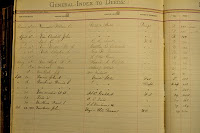U.S. Highway 50 crosses the United States from Ocean City, Maryland to West Sacramento, California. In eastern Kansas, from Overland Park to Emporia, the route is overshadowed by the bigger and quicker I-35.
 |
| Silkville, Kansas one room school, circa 1890 |
I was driving south of Williamsburg on old Highway 50 toward Emporia. I drove this route only because I had traveled hundreds of times along the newer and faster I-35 from Wichita to Kansas City. I needed a break. Old Highway 50 is a meandering route that meets up with Emporia where the newer I-35 and I-335 are. West of Emporia, the highway heads through the Flint Hills crosses though Strong City, arrives at Newton, and then proceeds on to Colorado and eventually West Sacramento, California..
Going east of Emporia, it parallels I-35 for the most part, heading up towards Overland Park and Kansas City.. Often, while driving along, you can look to the left or right, for the road wanders back and forth across I-35, and see cars and trucks tooling along. crossing the newer highway her and there before swinging to the east.
Highway 50 is for most of the way a two-lane blacktop. Yes, the kind of road that reminds you of the 1971 movie of the same name, starring James Taylor and Beach Boys Drummer Brian Wilson. Today, the highway is so quiet you could drive for miles without being passed in either direction. But, there, a few miles south of Williamsburg, stood an old stone one room school house. The construction was familiar - native Kansas limestone packed with seashells. An entrance door faced south with one windows on either side. In many one room schools, double doors mark the separate entrances for the two sexes. This school was too small to accommodate the idea. On the east and west walls, three windows let in light for the students to study. The north-western wall was solid Kansas limestone, intended to shield the students from the hot afternoon sun.
Walking around the perimeter, revealed the old cistern where water was drawn for thirsty students. At the corner of the intersection Douglas and Arkansas, just off of old Highway 50, stood the remnants of an old tree cut down years ago. The size of the stump indicated that it had been there when children still went to school. An old mulberry tree stood to the rear of the school.
The interior of the school is open to visitors. If you go, please close the door.
Nothing remains of the interior, but the floor. As you enter the front door, five feet or so from the door, the chimney which heated the room stands tall and sturdy. Once upon a time, walls extended to each side of the school, providing some protection from the cold winters. The walls in the school were once stuccoed, but much of the stucco has either fallen or been defaced by students who scratch their names in the soft limestone.
The real story of Silkville, Kansas is quite interesting.
 |
| Silkville School 1884, from Kansas Memories |
The Story of Silkville.
Boissere's workers planted seventy acres of Russian mulberry trees to feed the silkworms. Later, Boissiere learned that the Kansas Osage Orange were as good or better than the mulberry. Moreover, the Osage Orange withstood the harsh Kansas cllimate. One wonders if the old mulberry behind the school is a remnant of Boissere's plantings.
Utopias never last. Later, when his business failed, he made the mansion an orphanage.By 1878, Boissere left Kansas for France with little more than $200 in his pocket. The school house is all that remains.
































